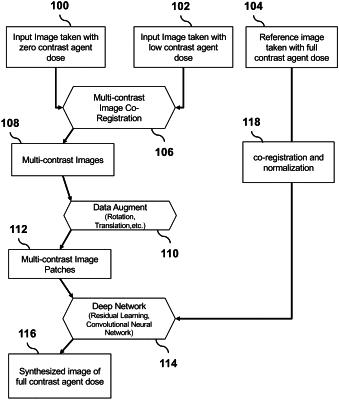| CPC G06T 7/0012 (2013.01) [G06N 3/08 (2013.01); G06T 3/60 (2013.01); G06T 5/002 (2013.01); G06T 7/50 (2017.01); G16H 30/40 (2018.01); G06T 2207/10072 (2013.01); G06T 2207/10081 (2013.01); G06T 2207/10088 (2013.01); G06T 2207/10121 (2013.01); G06T 2207/10132 (2013.01); G06T 2207/20081 (2013.01); G06T 2207/20084 (2013.01); G06T 2207/20221 (2013.01); G06T 2207/30004 (2013.01); G16H 50/20 (2018.01)] | 13 Claims |

|
1. A method for improving quality of a medical image of a subject, the method comprising:
a) acquiring a first image with a first image acquisition sequence, wherein the first image is acquired with zero contrast agent dose administered to the subject;
b) acquiring a second image with a second image acquisition sequence distinct from the first image acquisition sequence, wherein the first image and the second image are acquired using a common imaging modality, wherein the second image is acquired with zero contrast agent dose administered to the subject;
c) processing the first image and the second image to adjust for acquisition and scaling differences; and
d) applying the first image and the second image as input to a deep learning network (DLN) to generate as output of the DLN an image of the subject with an enhanced quality.
|